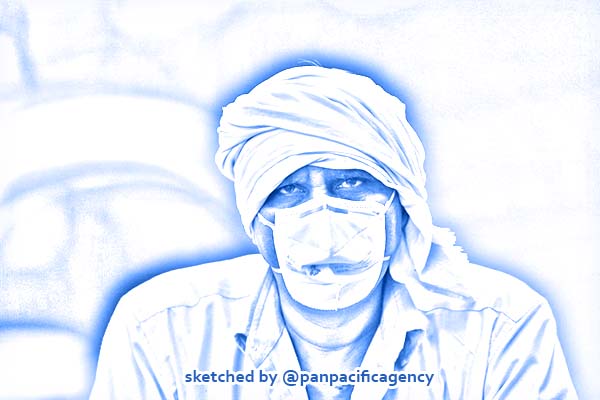Deadly air pollution may cut 17 years from a Delhiite’s life

A man wearing a protective face mask rides a bicycle along a street in smoggy conditions in New Delhi on November 4, 2019. Millions of people in India's capital started the week on November 4 choking through (Agence France Presse/Jewel Samad). Sketched by the Pan Pacific Agency.
NEW DELHI, Nov 21, 2019, India Today. Longer life expectancy is a sign of healthy society. But cities like Delhi which get enveloped in “emergency” levels of smog every year may face the threat of lower life expectancy. In fact, air pollution, mainly the concentration of the most dangerous pollutant known as PM2.5, may cut short the life expectancy of Delhiites by 17 years, India Today reported.
At present, residents of Delhi are breathing about 25 times more toxic air (as on November 19) than the permissible limit according to World Health Organization (WHO) guidelines.
India Today Data Intelligence Unit (DIU) analysed PM2.5 levels in Delhi and mapped them with Air Quality Life Index (AQIL), a statistical model to estimate the impact of air quality on life expectancy, i.e. the number of years one is expected to live from the time (s)he is born.
In the last 20 days, Delhi has witnessed an average PM2.5 level of 254, almost 30 points above the same period in 2018.
Though this level does not remain the same throughout the year, but the high concentration of deadly pollutants shows that Delhi’s mortality rate due to poor air quality is likely to spike in the coming days, and for this, Delhiites may live around 17 years less than their expected life. However, this estimate is based on the current average PM2.5 level in the Capital.
Michael Greenstone and Claire Qing Fan of Energy Policy Institute at The University of Chicago analysed PM2.5 data of 2016 through their AQIL tool. They found that “the average resident of Delhi will live about 10 fewer years because of high pollution while those in Beijing and Los Angeles will live almost six and almost one fewer years, respectively”.
Things have only worsened in the last three years it seems.
PM2.5 is a micro pollutant, just 3 per cent the width of a human hair. It enters the bloodstream rapidly and creates clots, blocking the blood flow, and may lead to brain or heart attack, along with other diseases. PM2.5 pollution contributed to nearly 30 lakh early deaths in 2017 – more than half of it in China and India.
“Air pollution is the fifth leading risk factor for mortality worldwide. It is responsible for more deaths than malnutrition, alcoholism and physical inactivity. Each year, more people die from air pollution-related diseases than from road traffic injuries or malaria,” the State of Global Air Report 2019 said.
Globally, air pollution reduces life expectancy on an average by one year and eight months – a loss that ranks just below those related to smoking but above unsafe drinking water and lung cancer.
Data of the last 28 years shows that high concentration of PM2.5 has always turned into a catastrophe. Air pollution killed more than 50 lakh people globally in 2017. However, the mortality rate in India due to air pollution is much higher – 134 per 1,00,000 – than the global average of nearly 64 per 1,00,000.
Exposure to air pollution is linked with diseases, including respiratory and heart diseases, stroke, lung cancer and diabetes. According to the State of Global Air Report 2019, air pollution accounts for 41 per cent of global deaths from chronic obstructive pulmonary disease (COPD), 20 per cent of deaths from type 2 diabetes, 19 per cent of deaths from lung cancer, 16 per cent of deaths from ischemic heart disease and 11per cent of deaths from stroke.
Air pollution also contributes to communicable diseases, for example, 35 per cent of deaths from lower respiratory infection. These instances of ailments vary among countries with different relative levels of ambient and household air pollution.
Recently, the Delhi government declared a public health emergency as toxic pollutants in the air spiked to severe levels. Heavy pollution is mainly caused by the thermal power industry, vehicles and farmers burning stubble in north India.